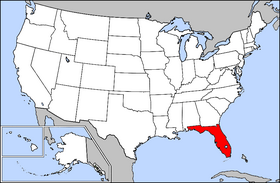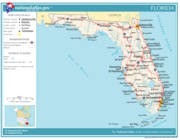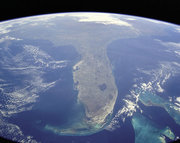Florida
|
|
| |||||
| State nickname: Sunshine State, Everglade State | |||||

| |||||
| Other U.S. States | |||||
| Capital | Tallahassee | ||||
| Largest city | Jacksonville | ||||
| Governor | Jeb Bush | ||||
| Official languages | English | ||||
| Area | 170,451 km² (22nd) | ||||
| - Land | 137,374 km² | ||||
| - Water | 30,486 km² (17.9%) | ||||
| Population (2000) | |||||
| - Population | 15,982,378 (4th) | ||||
| - Density | 114.43 /km² (8th) | ||||
| Admission into Union | |||||
| - Date | March 3, 1845 | ||||
| - Order | 27th | ||||
| Time zone | Eastern: UTC-5/-4 Central: UTC-6/-5 (western panhandle) | ||||
| Latitude | 24?30'N to 31?N | ||||
| Longitude | 79?48'W to 87?38'W | ||||
| Width | 260 km | ||||
| Length | 800 km | ||||
| Elevation | |||||
| - Highest | 105 m | ||||
| - Mean | 30 m | ||||
| - Lowest | 0 m | ||||
| Abbreviations | |||||
| - USPS | FL | ||||
| - ISO 3166-2 | US-FL | ||||
| Web site | www.myflorida.com | ||||
Florida is a southern state in the United States. It is known as the Sunshine State. "Florida" is a Spanish adjective which means "flowery". It was discovered by Spanish explorers during the Easter season, which is called Pascua Florida in Spanish. The U.S. Postal abbreviation is FL.
USS Florida was named in honor of this state.
| Contents |
History
Main article: History of Florida
Archaelogical finds indicate that Florida had been inhabited for many thousands of years prior to any European settlements. Spaniards first arrived in 1513 and laid claim to a large, imprecisely defined area extending from about modern day Gainesville northward to the Carolinas, which they called La terra florida, "The flowery land". Over the following century, the Spanish and French both established settlements in Florida, with varying degrees of success. The area of Florida diminished with the establishment of British colonies to the north and French colonies to the west. Control of parts of Florida passed among Spanish, British, and American control. Spain finally ceded Florida to the United States with the Adams-On�Treaty in 1819, in exchange for the US renouncing any claims on Texas. On March 3, 1845, Florida became the 27th state of the United States of America. Florida seceded from the Union on January 10, 1861 and was one of the founding members of the Confederate States of America (CSA, also known as the Confederacy). Florida joined the CSA on February 10, 1861. After the fall of the Confederacy in 1865, Florida was readmitted into the Union on June 25,1868. Today, Florida is the fourth most populous state in the Union.
Law and Government
The Florida Legislature has a Senate of 40 members and a House of 120 members. The current governor is Republican Jeb Bush, brother of President George W. Bush and son of former President George H. W. Bush.
Though Florida has traditionally been a Democratic state, in recent years explosive population growth has brought with it many Republicans, leaving the state approximately evenly split between the two parties. Despite this demographic parity, Republicans control the governorship and most other statewide elected offices; both houses of the state legislature; 18 of the state's 25 seats in the House of Representatives; and one of the state's two senate seats. The Presidential election in Florida in 2000 was extremely close. As such, and because of its high population and large number of electoral votes, Florida is considered by political analysts to be a key swing state in Presidential elections.
In Miami, the liberal Democrats vie for control with wealthy Cuban conservative Republicans and their business allies. Tampa, once a hotbed of Democratic union support, is now about 50% both registered Republicans and Democrats making it, and surrounding areas, part of the important I-4 Corridor swing region. Outside of liberal Miami-Dade, Broward and Palm Beach counties, the Florida Democratic Party tends to be socially conservative and heavily associated with the good ol' boy network. See: List of Florida Governors
Taxation
Florida is one of the nine states which does not impose personal income tax (list of others). The state sales tax rate is 6 percent. Local governments may levy a local option sales on top of that, so sales taxes vary by county between 6 and 7.5 percent. The state use tax is 6 percent on purchases made out of state and brought into Florida within 6 months of the purchase date.
Geography
See: List of counties in Florida
Florida consists of a panhandle extending along the northern Gulf of Mexico and a large peninsula with the Atlantic Ocean as its eastern border and the Gulf of Mexico as its western border. It is bordered on the north by the states of Georgia and Alabama and on the west, at the end of the panhandle, by Alabama. It is near the countries of the Caribbean, particularly the Bahamas, Cuba, and Haiti.
At 345 feet (105 metres) above sea level, Britton Hill is the highest point in Florida (it's also the lowest state highpoint.)
Climate
Hurricane_Frances,_September_2nd.jpg
The climate of Florida is tempered somewhat by its proximity to water. Most of the state has a humid subtropical climate with the extreme tip of Florida and the Florida Keys bordering on a true tropical climate. The seasons in Florida often called "Hot and Hotter" are actually determined more by precipitation than by temperature with warm, relatively dry winters and autumns (the dry season) and hot, wet springs and especially the summers (the wet season). The Gulf stream has a moderating effect on Florida climate and although it is common for much of Florida to see a high summer temperature over 90 degrees Fahrenheit, it is not common for the mercury to go above 100 degrees Fareinheit in Florida.
While Florida's nickname is the "Sunshine State", severe weather is a common occurrence in Florida. Statewide, Florida has the highest average precipitation of any state, due in large part to afternoon thunderstorms which are common throughout most of the state from late spring until the early autumn. These thunderstorms which are caused by airflow from the Gulf of Mexico seemingly "pop up" in the early afternoon and can often bring heavy downpours, high winds and sometimes tornadoes. Florida has more lightning strikes than any other state and also leads the nation in tornadoes per square mile(although the tornadoes in Florida do not get as large as those in the Midwest or Great Plains. Hail is not an uncommon occurrence in some of the more severe thunderstorms.
Snow is a rare occurrence in Florida, although it usually snows somewhere in Florida almost every winter. During the Great Blizzard of 1899, Florida experienced blizzard conditions for possibly the first time. During that time, the Tampa Bay area had "Gulf effect" snow, similar to Lake effect snowfall. The Great Blizzard of 1899, was also the only time the temperature has fallen below 0 degrees Fahrenheit, registering -2f in Tallahassee. The most widespread snowfall in Florida history happened in February 1978 with snow falling over much of the state in different times of the month, extending as far south as Homestead. Snow flurries fell on Miami Beach for the only time in history.
Hurricanes pose a threat during the summer and fall. Florida saw a slew of destruction in 2004 when it was hit by a record four hurricanes. Hurricanes Charley (August 13), Frances (September 4-5), Ivan (September 16), and Jeanne (September 25-26) cumulatively cost forty-two billion dollars to the state. Florida was also the site of the most costly single weather disaster in U.S. history, Hurricane Andrew, which cost twenty-five billion dollars when it struck on August 12, 1992. Among a long list of other infamous hurricane strikes were the Miami Hurricane of 1926, the Lake Okeechobee Hurricane of 1928, the Labor Day Hurricane of 1935, Hurricane Donna in 1960 and Hurricane Opal in 1995. Many other smaller hurricanes have hit or brushed Florida, and many more hurricanes will hit in the future.
Economy
The gross state product of Florida in 2003 was $550 billion. The per capita personal income was $30,098, ranking 26th in the nation.
Florida's economy is heavily based on tourism. Warm weather most of the year and hundreds of miles of beach provide a thriving vacation spot for travelers from around the world. The large Walt Disney World Resort with four theme parks and over twenty hotels plus countless water parks, shopping centres and other facilities, located in Lake Buena Vista drives the economy of that area, along with more recent entries into the theme park arena such as the Universal Orlando Resort. The great amount of sales tax revenue is what allows the state to be one of the few to not levy a personal income tax. Other major industries include citrus fruit and juice production, banking, and phosphate mining. With the arrival of the space program at Kennedy Space Center in the 1960s, Florida has attracted a large number of aerospace and military industries to the state. Florida did not have any state minimum wage laws until November 2, 2004, when voters passed a Constitutional Amendment requiring inflationary increases to the minimum wage every six months.
In 2005 Spamhaus declared Florida the spam capital of the world [1] (http://www.sun-sentinel.com/news/local/southflorida/sfl-sbspammain08may08,0,7702631.story?coll=sfla-home-headlines). Experts have estimated that Florida is an attractive place of business for Spammers due to the gorgeous weather, low key atmosphere, nearby Internet data centers and the state's reputation as "a good place to do dirty business". Spammers are not the first business men of questionable ethics to use Florida as a home base. Historically Florida has also been home to large telemarketing firms. Today most of the spam businesses appear to be operating out of South Florida.
Demographics
Race
As of 2003, the state had a population of 17,019,068.
| White | 65.4% | |
| Hispanic | 16.8% | |
| Black | 14.6% | |
| Asian | 1.7% | |
| American Indian | 0.3% | |
| Mixed Race | 2.4% |
The five largest ancestries in the state are: African American (14.6%), German (11.8%), Irish (10.3%), English (9.2%), American (8%).
Religion
Religiously, Florida is mostly Protestant, but with a growing Roman Catholic community due to Hispanic immigration.
| Protestant | 60% | |
| Roman Catholic | 23% | |
| Other Christian | 2% | |
| Other Religions | 4% (largely Jewish) | |
| Non-religious | 8% |
The three largest Protestant denominations in Florida are: Baptist (22% of the total state population), Methodist (8%), Presbyterian (4%).
Important cities and towns
City Population
|
Population > 1,000,000 Population > 100,000 |
Population > 10,000
|
Wealthiest Cities
Ranked by per capita income
| 1 | Fisher Island, Florida | $236,238 |
| 2 | Jupiter Island, Florida | $200,087 |
| 3 | Golf, Florida | $144,956 |
| 4 | Manalapan, Florida | $143,729 |
| 5 | Indian Creek, Florida | $137,382 |
| 6 | Orchid, Florida | $135,870 |
| 7 | Gulf Stream, Florida | $133,651 |
| 8 | Palm Beach, Florida | $109,219 |
| 9 | Indian River Shores, Florida | $102,511 |
| 10 | South Beach, Florida | $90,938 |
| 11 | Pelican Bay, Florida | $89,063 |
| 12 | Oak Point, Florida | $86,225 |
| 13 | North Key Largo, Florida | $83,199 |
| 14 | Longboat Key, Florida | $80,963 |
| 15 | Weston, Florida | $80,920 |
| 16 | North Beach, Florida | $79,269 |
| 17 | Captiva, Florida | $76,139 |
| 18 | Ocean Ridge, Florida | $76,088 |
| 19 | Golden Beach, Florida | $73,053 |
| 20 | Bal Harbour, Florida | $67,680 |
| 21 | Highland Beach, Florida | $67,288 |
| 22 | Sanibel, Florida | $66,912 |
| 23 | Boca Pointe, Florida | $66,797 |
| 24 | Jupiter Inlet Colony, Florida | $66,713 |
| 25 | Sawgrass, Florida | $64,798 |
| 26 | Belleair Beach, Florida | $61,569 |
See complete list of Florida places
Education
Florida's public school revenue per student and spending per $1000 of personal income usually ranks in the bottom 25% of U.S. states. Average teacher salaries rank near the middle of U.S. states.
Florida public schools have consistently ranked in the bottom 25% of many national surveys and average test score rankings. It should be noted that many education surveys are not scientific, but do measure prestige. Governor Jeb Bush has been criticized by many Florida educators for a program that penalizes underperforming schools (as indicated by standardized tests, such as the FCAT) with fewer funding dollars. Major testing organizations frequently discount the use of state average test score rankings, or any average of scaled scores, as a valid metric (see psychometrics for more details on scaled test scores).
In 2000, Governor Bush and the state legislature acted to abolish the Board of Regents that governed the State University System of Florida. Instead, each public university is now controlled by its own Board of Trustees who are directly appointed by the governor. As is typical of executive-appointed government boards, the appointees so far have been overwhelmingly Republican. This has not been without controversy. [2] (http://www.sptimes.com/News/050801/State/Bush_s_trustees_mostl.shtml) In 2002, Democratic Senator Bob Graham started a ballot referendum designed to revert to the Board of Regents system.
Colleges and universities
Sports
Professional sports teams in Florida
Spring training
Florida is an extremely popular location for Major League Baseball spring training, with teams informally organized into the "Grapefruit League". As of 2004, Florida hosts the following major league teams for spring training:
- Atlanta Braves at Walt Disney World
- Baltimore Orioles in Fort Lauderdale
- Boston Red Sox in Palms Park
- Cincinnati Reds in Sarasota
- Cleveland Indians in Winter Haven
- Detroit Tigers in Lakeland
- Florida Marlins in Jupiter
- Houston Astros in Kissimmee
- Los Angeles Dodgers in Vero Beach
- Minnesota Twins in Fort Myers
- Washington Nationals in Viera
- New York Mets in Port St. Lucie
- New York Yankees in Tampa
- Philadelphia Phillies in Clearwater
- Pittsburgh Pirates in Bradenton
- Saint Louis Cardinals in Jupiter
- Tampa Bay Devil Rays in St. Petersburg
- Toronto Blue Jays in Dunedin
Minor League teams
Florida also hosts the following minor league baseball teams:
Clip Art and Pictures
- Free Clipart (http://classroomclipart.com)
State Flags
- US State Flags (http://classroomclipart.com/cgi-bin/kids/imageFolio.cgi?direct=Clipart/State_Flags)
State Maps
- Printable Black and White Map of Florida (http://www.lessonplancentral.com/statemaps/Florida_mapBW.htm)
Lesson Plans, Resources and Activites
- Lesson Plan Central (http://lessonplancentral.com)
- Florida Lesson Plans (http://lessonplancentral.com/lessons/Social_Studies/State_Facts/Florida/index.htm)
External links
- The Official Portal of the State of Florida (http://www.state.fl.us)
- Florida State Information (http://www.eachtown.com/state_info.php/stateid/10)
- Florida State University (http://www.fsu.edu)
- la Voie de Miami News (http://www.iespana.es/Miami)
- University of Florida (http://www.ufl.edu)
- My Florida (http://www.myflorida.com)
- Florida Visiting (http://www.floridavisiting.com)
- Florida Tourism (http://www.flausa.com)
- Florida Entertainment (http://www.magicmomentproductions.com)
- US Census Bureau (http://quickfacts.census.gov/qfd/states/12000.html)
- Roundtrips with a lot of Pictures (http://www.anhinga.info/florida/index.html)
- Photos of Florida - Terra Galleria (http://www.terragalleria.com/america/florida/)
- Florida Southern College (http://www.flsouthern.edu)
- Florida Nature Travel/Ecotourism (http://ecofloridamag.com)
- Florida Obituary Links Page (http://obit.obitlinkspage.com/fl.htm)
- Florida Information (http://www.floridazest.com)
- GenealogyBuff.com - Florida Library of Files (http://www.genealogybuff.com/fl/)
- Florida Rivers Discussion Forum (http://www.floridarivers.org/)
- Florida Newspapers (http://www.mediatico.com/en/newspapers/northamerica/usa/florida/)
- Palm trees in Florida (http://roamingfeet.com/id22.htm)
- Florida Memory Project (http://www.floridamemory.com/)
| Political divisions of the United States | 
| ||||||
|---|---|---|---|---|---|---|---|
| |||||||



